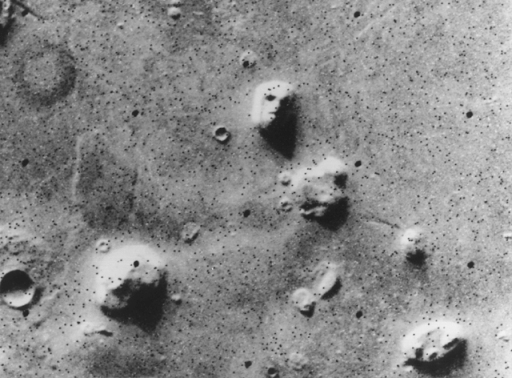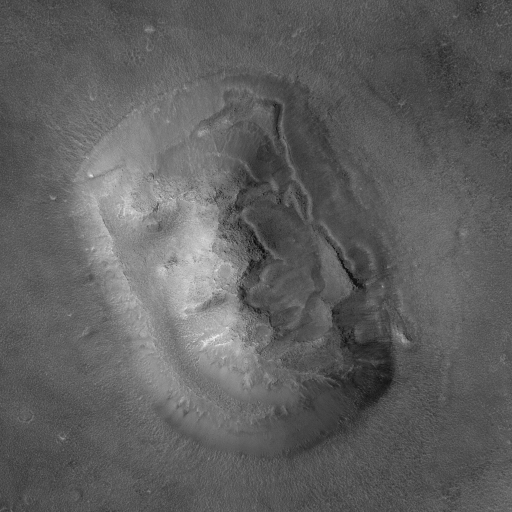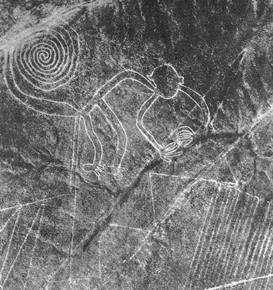The face on Mars – and other questions
Aug. 07, 2014, under history, opinions, philosophy, puzzling, space t/e/d
As it circled Mars on the 25th of July 1976, NASA’s Viking 1 orbiter photographed the Cydonia region of Mars. One of the frames included an image of a 2 km (1.2 miles) long mesa, situated at 40.75 degrees north latitude and 9.46 degrees west longitude, with the appearance of a humanoid face.

The “Face on Mars” photo captured by NASA’s Viking 1 orbiter on 25 July 1976
When the image was originally acquired, Viking chief scientist Gerry Soffen dismissed the “Face on Mars” in image 035A72 as a “trick of light and shadow.” In a press release issued on 31 July 1976, NASA provided a caption for the picture stating “The picture shows eroded mesa-like landforms. The huge rock formation in the center, which resembles a human head, is formed by shadows giving the illusion of eyes, nose and mouth. …”
Since it was originally first imaged, the “face” has been nearly universally accepted as an optical illusion. On 8 April 2001 the Mars Global Surveyor turned so it was looking at the “face” 165 km to the side from a distance of about 450 km. The resulting image has a resolution of about 2 meters (6.6 feet) per pixel in its full-resolution (2400 x 2400 pixels) version. As noted on the Malin Space Science Systems page, “If present on Mars, objects the size of typical passenger jet airplanes would be distinguishable in an image of this scale.”

MGS view of the “Face on Mars” mesa, MOC image E03-00824, 8 April 2001
Click the image to see the full-resolution frame (2400 x 2400 pixels)
The region was also studied by ESA’s Mars Express orbiter. Combining the MGS and Mars Express data, a three dimensional model of the “Face” was constructed.

3D computer-generated model of the “Face on Mars” mesa
After examining the higher resolution Mars Express and Mars Global Surveyor data NASA stated that “a detailed analysis of multiple images of this feature reveals a natural looking Martian hill whose illusory face-like appearance depends on the viewing angle and angle of illumination.” That certainly seems a plausible conclusion, especially in a universe where humans are the only intelligent species in a solar system which has never been visited by extraterrestrials, and civilization spontaneously appeared in Mesopotamia around 4,000 B.C.
In the high Andes mountains in South America, the Nazca plateau is covered with drawings that are best seen from the air. Popular belief is that they can only be seen from the air, but “more reasoned” analysis asserts they can be seen from the surrounding hills.

Monkey image, part of the Nazca plateau lines, Peru
The designs are shallow lines made by removing reddish pebbles from the surface to uncover the whitish/grayish ground beneath. Hundreds are simple lines or geometric shapes; more than seventy are zoomorphic designs of animals, or human figures. Other designs include phytomorphic shapes such as trees and flowers. The largest figures are over 200 metres (660 ft) across. Who made them, and why? Theories abound, but every one of them is just that – a theory. No one really knows.
How were Egypt’s pyramids built? I don’t know, I wasn’t there at the time. Opinions differ, but I have a hard time swallowing some of the “scientifically acceptable” ones. Those stones are just too big and there are too many of them for the technology level that was supposed to have built the pyramids. There are also assertions that the Sphynx was thousands of years old when the pyramids were built. If that is true, who made the Sphynx? While we’re on it, where did the technology come from that was used to build Machu Picchu, nearly 8000 feet above sea level? A lot of those stones are so big we’d have a hard time moving them today, let alone placing them well enough that you can’t fit a piece of paper between them – yet there they are, built up for us to look at. How did that happen? Again, I wasn’t there at the time, so I can’t express anything more than an opinion on the matter – and my opinion is that we don’t have all of the answers.
If humanity and its civilization were to disappear (e.g., through nuclear war at the end of the oil supply, a disaster I’m trying to avert through Space Power Now), the pyramids would most likely still be there on the Cairo plain, even though effectively all of the other signs of our existence would be gone. The pyramids would probably be eroded, but their form would be easily distinguishable from space if the lighting and viewing angle were right, even in a low resolution image. If, for some reason, Earth’s atmosphere leaked away in the mean time, as has apparently happened to Mars, the recognizable life expectency of the pyramids would grow rapidly.
When a bullet hits a ball, different outcomes will occur, depending on the speed and size of the bullet, and the composition of the ball. A high speed bullet hitting a solid, brittle ball will cause the ball to shatter, for example. A slower projectile, such as a BB, will make a crater and embed itself in a softer ball. Somewhere between those extremes there’s a class of collisions with bizarre results: If a bullet going just the right speed, fast enough to tear through but slow enough to not completely explode it, hits a ball with a relatively soft center and a tough skin (think of an orange), a “mountain” will form at the entry point, and the skin on the opposite site will be torn off. The center of mass will change, conceivably to the point where the now-rough side that lost its skin is farther from the center of mass – at a “higher elevation” even though it just had its face blown off. The surface of Mars is remarkably close to this description: Olympus Mons, the tallest known mountain in the solar system, is in the smooth northern hemisphere, nearly diametrically opposite the giant Hellas crater situated in the southern highlands that have some of the roughest terrain on any planet in orbit around the Sun. I haven’t done an extensive analysis, but I have to wonder – was Mars hit by a cosmic bullet some time in the past that almost destroyed it?
Let’s consider for a moment a situation where our astronomers found a comet whose orbit was going to intersect the Earth’s in, say, ten years, and that the nucleus of the comet was big enough so there’d be no way to divert it: The Earth was going to die in ten years, and there’s nothing we could do about it. What would we do, in that case? I, for one, would be pushing real hard to build spaceships to carry at least some people to another planet. When they got to their destination, it could be thousands of years before the refugees would be able to start exploring out into the universe again: Chances are that something critical would be missing at their new home, and although humanity would survive, civilization would collapse. Recognizing that, what would be the best thing for the rest of us to do, so that once the survivors did get back on their feet, they could find their way home to see if anything was left of the world they came from? Put up a sign they could recognize from a long ways away, something to say “Hey you – come look here!” A face looking out into space would do the trick, I think. If there was uncertainty about which direction the comet was going to hit from, I’d even go as far as building four faces at the apexes of a regular tetrahedron, 120 degrees from each other in any direction, to improve the chances at least one would survive the impact.
It would probably be tens or hundreds of thousands of years, millions even, before the expatriats might come back, looking for something they couldn’t define. Over that time, anything smaller than the great pyramid of Cheops would probably erode away – it would take carving a mountain into the shape of a face to have any real hope of keeping the sign up long enough for it to be found. Before actually landing on the planet, our distant relatives, while initially startled by finding the Face, would probably get a closer look then dismiss it as “a natural looking … hill whose illusory face-like appearance depends on the viewing angle and angle of illumination.”
Wait a minute. What was that the NASA analysis decided?
Maybe it’s time we went and took a closer look – time for humans to go and look, not just our robots.
An interesting coincidence is that in 1958, almost two decades prior to the first images of the Face from the Viking probes, comic book artist Jack Kirby wrote a story entitled “The Face on Mars” for Harvey Comics (Race for the Moon Number 2, September 1958), in which a large face served as a monument to an extinct humanoid race from Mars. While Mr. Kirby’s face was standing vertically, and much smaller than the one found by Viking 1, his tale is eerily prescient of the discovery – something to make you go “hmm…”
We are going to run out of oil. Before that happens, we MUST have a replacement source of energy and feed stock for our civilization that has become so dependent on plastic. The time to act is NOW!! Please visit SpacePowerNow.org to help build a solution.





